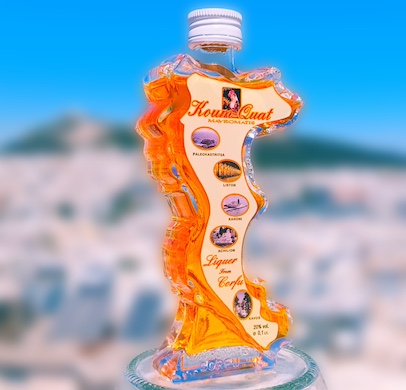To Corfu for the Weekend? Yes, With Kumquat Liqueur and Faded Grandeur Aplenty
On the northerly Greek island famed for its Venetian allure and British heritage, the traveler need not seek out history — it comes to you, in various guises.

CORFU, Greece — On such a hauntingly beautiful island as this, a mostly graceful green phantom adrift in the ridiculously blue Ionian Sea, ghosts come in numerous guises. The more locally produced kumquat spirits one imbibes, the faster they come.
Arriving by sea is the best way to get this journey started. That way one’s first view of the island will be of the old fortress at harbor’s edge, owned by Venice until that republic fizzled in 1797. Yet for my money, it is the sight of another relic, Mon Repos, that sticks.
It is the small summer palace where Prince Philip, duke of Edinburgh, was born — on a dining room table, it is said. That apocryphal story reminds me of the time that the prince’s future spouse, Queen Elizabeth II, made a lighthearted video about tucking marmalade sandwiches into her handbag.
The villa was built for the British lord high commissioner when Corfu was capital of the United States of the Ionian Islands.

Today the place is in a state of eerie if benign neglect. The main portico and a smaller, semi-elliptical one facing the sea are devoid of activity, but the humid air is pregnant with forgotten pomp. The panorama of the sea stretches to mainland Greece in one direction and the Albanian coast in the other. The sound of the waves entices, but the old pathway down to the sea is closed.
The lush if unmanicured garden setting and the general hush of the place instantly transport me to one of the pricier precincts of my native Santa Barbara: Montecito. That is where my fellow Californian, Meghan Markle, duchess of Sussex, has set up shop (literally) and, indeed, as I made my way to the ruins of an ancient Doric temple on the grounds, a vision of her future spirit — one that almost gleefully turns its back on the past — appeared.
One needn’t venerate royalty to feel that a small palace in a place as ravishing as this could be so much more than a fossil. Without respect for cultural heritage, the sense of a place, or an institution, is diminished. Such spots precipitate deep thoughts, and mine turned to the perceptible bruises now endured by the British monarchy, due at least in part to the narcissism of some of its ersatz affiliates.
Does Corfu have wonderful beaches and fine restaurants? There is a plethora of both, but there is still a kind of torpor that hangs over much of the island’s human imprint. Take another mythic location of faded grandeur, the Achilleion. Clinging to a hilltop above the village of Gastouri, a few miles down the road from Mon Repos, it is the rambling and disused, albeit photogenic, palace built for the Empress Elisabeth of Austria, familiarly known as Sisi, in 1889.
The interiors are, alas, closed for renovation, but on a weekday visit all was quiet on the restoration front.

As its name indicates, the prevailing motif here is Achilles. In one section of a garden more remarkable for its overgrown weeds than its unruly flower beds, there is a striking statue of a dying Achilles, a spear stuck in that mythic stony heel. In another section, in front of a giant bronze statue of the hero, there is a stunning view of verdant hills and valleys framed by the blue sea.
Seaside diversion is the reason that most people come to Corfu, and it is not hard to see why: The interplay between shimmering water and the cliffs that frequently plunge down to it is frequently dramatic. It takes some stamina behind the wheel to navigate the hairpin turns and frequently confusing signage, but ample compensation comes in the form of landscapes alive with tall cypress and blossoming citrus trees.
The best beaches are on the west coast and include Glyfada Beach, a beautiful curl of golden sand that as in other locations is a bit marred by some modern coastal development. A ways farther north but still facing west toward Italy, a small rock in the sea is said to be the petrified ship of Odysseus. The tale is more believable with a fine beer from the Corfu Brewery in hand, but the surrounding beaches and bluffs of Palaiokastritsa are undeniably spectacular.
Unfortunately, they do attract plenty of tourists. The general rule of Greek islands is that when they have an airport, as does Corfu, there are few if any secrets left. Sadly, too, mass tourism encroaches on what used to be called the spontaneity of travel.
In Corfu Town today, that sort of serendipity is sadly almost completely absent. One cannot simply blame Instagram or the huge cruise ships that disgorge passengers daily for that, but one can blame the unpleasant alchemy that comes when the two mix.
Think soulless Airbnbs everywhere (except maybe here, where I stayed) and little piazzas galore, packed with visitors not so much enjoying the sunshine as taking pictures of themselves pretending to do so. At least the narrow byways form part of a large car-free zone, but one almost pines for a roar of traffic if it would deter the crowds. The renowned Liston arcades, which the French erected in Napoleonic times to mimic the Rue de Rivoli, do daily battle with the tourist hordes and schmaltzy shops that cater to them — the jury is out on the winner.
The tangle of the old town is intact and it still resembles Venice in certain pockets, minus the canals. The Venetians built ramparts so sturdy that unlike the antique summer palaces and villas where royals took tea, they hardly require a do-over.
Driving along the perimeter of the ramparts I spotted some technicolor pink snapdragons tickling the white marble tail of the Lion of St. Mark, set high into the wall. I stopped the car for a closer inspection but forgot to check the rearview mirror. There’s nothing quite like being shouted at in Greek by the driver of a red double-decker tour bus to remind you what century this is.
Recommended is to temper that reality with a Corfu beer or anything with kumquats — on Corfu, they outnumber even the British heritage sites. Kumquat trees were brought to the island in 1924 and have been thriving ever since.
The little orange fruits make their way into all manner of libations, from a tangy, bright orange liqueur available almost everywhere on the island to soft drinks and my personal favorite, kumquat marmalade. That sweet spread will impart to any slice of bread some of the cosmopolitan flavor for which Corfu is justly famous.

